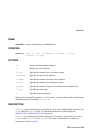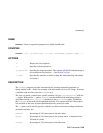rmsbuild(1)
Detailed information about each node (number of CPUs, amount of memory and so on) is
added later by rmsd as it starts on each node.
The machine name is specified with the -m option. Machines should be given a short
name that does not end a digit. Node names are generated by appending a number to
the machine name.
Database entries for the nodes are generated by the -n or -N options. Use -n with a
number to generate entries for nodes 0 through n-1. Use -N to generate entries for a
named list of nodes such as atlas[4-8].
Some systems include a management server. You should use the -I option to specify the
management server name and create a description of the management server in the
RMS database. To devise the management server name, append the letters ms to the
machine name; for example, atlasms.
rmsbuild is run after the system is installed, creating database entries for all installed
nodes. Additional entries can be added later if further nodes are installed.
If the demonstration mode is selected with the -d option, rmsbuild constructs the
entries for a demonstration database; that is to say, a database that does not necessarily
correspond to the physical resources of the system. Attributes of the nodes that would
normally be set by rmsd are set to representative values and a default partition is
created. The -d option is primarily for testing purposes but can be useful when
demonstrating RMS. When creating such a database, you should take care to give it a
different name from that of your system.
EXAMPLES
To create a description of a 64-node system called atlas with one management server,
use rmsbuild as follows:
# rmsbuild -m atlas -I ’atlasms’ -N ’atlas[0-63]’
To create a machine description for a 128-node system called demo, use rmsbuild as
follows:
# rmsbuild -d -m demo -n 128
SEE ALSO
rmstbladm, msqladmin
5-36 RMS Commands


















